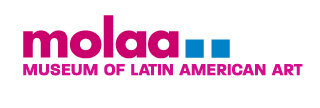Collections at MOLAA
The Museum of Latin American Art (MOLAA) was founded in 1996 in Long Beach, California and serves the greater Los Angeles area and the international community. MOLAA is the pioneering museum in the United States dedicated to modern and contemporary Latin American and Latino art. Since its inception, MOLAA has doubled its size and added a 15,000 sq. ft. sculpture garden. Its permanent collection now numbers over 1,300 works of art. MOLAA expands knowledge and appreciation of modern and contemporary Latin American art through its Collection, ground-breaking Exhibitions, stimulating Educational Programs, and engaging Cultural Events.
MOLAA’s permanent collection was started by Dr. Robert Gumbiner, an individual committed to promoting Latin American Art. In 2014, MOLAA’s Board of Directors approved the expansion of the scope of the museum’s mission to also include Latino Art. As MOLAA expands its collection, in depth research and documentation of the artwork continues to provide a solid base for the academic value of the collection. Private collections turned into museum collections require adequate documentation that will also provide the necessary information to identify growth opportunities for said collection.
If you have questions about our collection, please reach out to collections@molaa.org
Carlos Cruz-Diez (Venezuela, 1923-2019). Induction du jaune, 2007. Chromograph on paper mounted on aluminum, 70 7/8 x 31 1/2 inches. Gift of the artist.
Tribute to
Carlos Cruz-Diez (Venezuela, 1923-2019)
Carlos Cruz-Diez is a pioneer of Geometric Abstraction who creates research-based Op-Art works that explore perception, optics, and color. He studied the works of renowned color theorist Josef Albers and pointillist Georges Seurat, whose paintings explored the concept of visual vibration. In this print, Cruz-Diez triggers a phenomenon called Retinal Persistence or ‘post-image’ where residual visual impulses sent to the brain through the eye’s photoreceptor cells cause the viewer to perceive colors, shapes, or movement that are not present in the image. He accomplishes this by strategically juxtaposing geometric shapes in blue, white, and black causing the viewer to see a pulsating yellow hue that does not actually exist.

